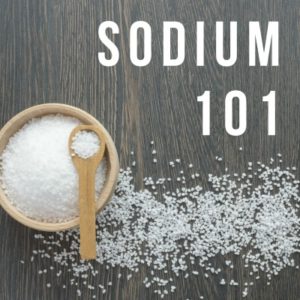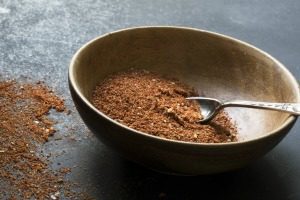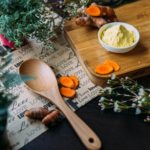 |
|
|
|
As we celebrate American Heart Month, the topic of salt and sodium is bound to come up. Is sodium really that bad for you? How much do you need? How much is too much? Where is the sodium sneaking into your diet? And how can you reduce sodium without compromising flavor.
This month I am going to explore those questions and more! Read more below...
- Stephanie
|
|
|
|
 The fact is everyone needs some salt to function. Salt, also known as sodium chloride, is essential for proper nerve and muscle function as well as balancing fluids in the body. And while some people, athletes in particular, are at risk for being too low in sodium, most people will benefit from watching their sodium intake. The fact is everyone needs some salt to function. Salt, also known as sodium chloride, is essential for proper nerve and muscle function as well as balancing fluids in the body. And while some people, athletes in particular, are at risk for being too low in sodium, most people will benefit from watching their sodium intake.
Not only does a lower sodium intake help manage blood pressure, reduce the risk of heart disease and stroke, it can also help decrease fluid retention and puffiness.
How much is too much?
Here is a summary of the daily recommendations from major health organizations:
- United States Department of Agriculture (USDA): 2300 mg
- American Heart Association (AHA): 1500 mg
- Academy of Nutrition and Dietetics (AND): 1500 to 2300 mg
- American Diabetes Association (ADA): 1500 to 2300 mg
The bottom line is, there is an agreement that the optimal limit is 1500 mg with no more than no more than 2300 mg of sodium or 1 teaspoon of added salt per day.
Over the years we have seen an increase in awareness on this topic and a decrease in the salt added at the dinner table. People are opting for lower sodium, salt free seasonings, low sodium soups, and trying to eat more fresh foods. However, the sodium continues to sneak into the diet, with the average intake about 3400 mg per day, which is approximately 1200 mg more than the daily recommendation.
Where is it coming from?
According to the FDA, about 75 percent of one’s total salt intake comes from salt added to processed foods by manufacturers and salt that cooks add to foods at restaurants and other food service establishments. Only about 10 percent of salt intake comes from foods in their natural state and another 10 percent comes from salt added while cooking or at the table.
This means that the majority of sodium is not coming in through table salt, but instead through products you consume. Beyond the obvious foods you know are high in sodium such as soups, broths, canned vegetables, pickled foods, deli meat and frozen entrees, here are not so obvious places sodium is sneaking in such as:
- Condiments
- Salad Dressing
- Cottage Cheese
- Vegetable Juices
- Salsa
- Bread
- Tortillas
Check out this month’s mini article to learn simple ways to reduce your sodium intake. |
|
|
|
|
|
|
|

Total time: 5 minutes Prep time: 5 minutes
Ingredients:
- 6 tablespoons chili powder
- 2 teaspoons garlic powder
- 2 teaspoons onion powder
- 2 teaspoons oregano
- 3 teaspoons paprika
- 3 tablespoons cumin
- 1 tablespoons ground pepper
- 1 - 2 teaspoons red pepper flakes (optional for added spice and kick)
Directions:
Mix ingredients together and store in an airtight container.
When the urge for tacos hits home add 1 - 2 tablespoons spice mixture with ½ to ¾ cup of water to one pound of meat of your choice.
Simmer over medium heat, stirring frequently until there is very little liquid left in pan.
Serve it up!
| |
| |
|
“The more you eat, the less flavor; the less you eat, the more flavor.”
~Chinese Proverb |
|
|
|
| Simple Ways to Slash the Salt |
|
|

- Before diving into how to slash the salt, it is important to understand how to read the label:
- "Reduced sodium" simply means it has 25 percent less sodium than the original version, it doesn't mean it is "low" sodium.
- "Low sodium" indicates the a product has 140 mg sodium or less per serving.
- "No salt added" means no salt has been added to the product, however it may contain naturally-occurring sodium.
- Shop the perimeter of the grocery store. This simple act of shopping around the perimeter of the grocery store will help ensure you are stocking up on more fresh produce, lean meats and bone building dairy instead of canned and boxed foods.
- Swap out traditional cheese for Swiss, part skim mozzarella or goat cheese. This simple swap can easily reduce the sodium content by half.
- Instead of buying pre-packaged biscuit, bread, and pancake mixes, try making your own from scratch.
- Cook with fresh herbs and spices or experiment with no salt seasoning blends.
|
|
|
|
|
| ABOUT SO Nutrition |  | Stephanie Leipprandt Ouellette, MBA, RDN, LD Stephanie has been working in the field of nutrition and dietetics since 1995. She earned a Bachelor of Science degree in Dietetics from Michigan State University, completed an Approved Pre-Professional Practice Program at Western Michigan University and earned a Master of Business Administration from Baker College. She’s been a Registered Dietitian Nutritionist since 1996 and licensed in Texas since 2007. In 2008, Stephanie earned her certification in Childhood and Adolescent Weight Management. Stephanie has extensive clinical & managerial experience, both in corporate settings and in the community. Now she wants to share her knowledge with you, because most (if not all) nutritional habits begin at home.
Stephanie and her family reside in Katy, Texas
|
|
| Copyright © 2017 Customized Nutrition Newsletters, All rights reserved. |
|
|